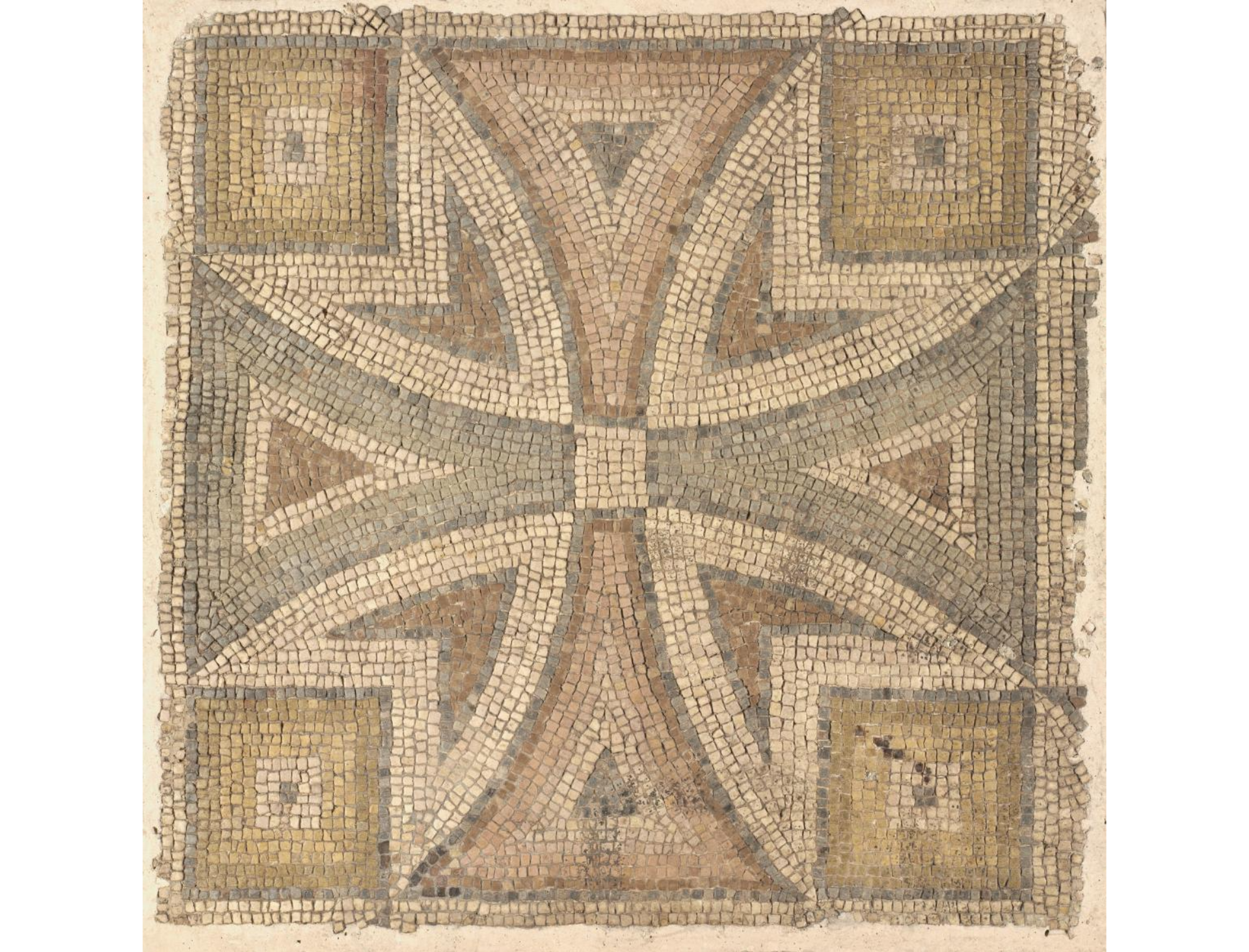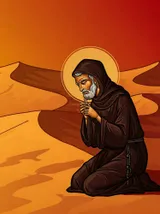Mosaics and other early Christian arts
To find the beginning of the use of colour in the Roman Empire to anything like an important extent, we must look at the Roman pavements composed of myriads of tesserae, and representing in a flat and somewhat uninteresting manner mystic beings, extraordinary animals, fruits, flowers, and designs. Between these Roman pavements and one branch of the earliest Christian art, that of mosaic, there is a very close connexion.
It seems also possible that some of the early efforts of the art of the Christian Church are to be found in the decorations of gold on glass which have been discovered in the catacombs. Upon these glasses dating from the third to the fifth century, are found representations of Christ and of the Apostles, as well as drawings in gold-leaf, partly symbolic and partly realistic, referring to the miracles of Christ, the emblems of the Seven Spirits, a future life, and the events narrated in the New Testament. Simple and archaic as these are, yet many of them show considerable beauty. The primitive Church included within itself, not only the poor and humble, but persons of distinction, rank, and attainment, and it is clear from an examination of these drawings that some were executed by those who were in possession of considerable artistic skill, and who had been trained in a knowledge of Greek and Roman art.
Contemporaneous with these, and earlier, are frescoes painted upon the walls of the catacombs, including portraits of the Apostles and of Christ, representations of the martyrs, naive pictures of the scenes from the Holy Bible, and simple illuminatory symbolism.

Then, between the fourth and tenth centuries there is a long series of mosaics, in which for the first time strong evidence appears of a sense of colour. A few specimens of these mosaics adorned the catacombs, afterwards they are found in the oratories and places of worship of the primitive Church. It was speedily recognized that mosaic decoration possessed certain strong claims to attention, such as other methods of decoration lacked. While the artist himself must be responsible for fresco work, very much of the labour in mosaic decoration could be left to persons of subordinate position, and once the artist had drawn out the pattern and scheme which was to cover, for instance, the apse of the church, the actual manual labour of fitting in the tesserae could be done by workmen. Then, again, there was the quality of imperishability; the mosaic was as permanent, an actual part of the structure which it decorated; it did not vary in colour by reason of light or atmosphere, and could be cleansed from time to time. It was also capable of strong, broad effects, rendering it peculiarly suitable to positions at the end of a building, somewhat above the line of sight, and its colour could be made so emphatic and so brilliant that the darkest of curves or hollows could be lit up by its luminous beauty.
It is small wonder, therefore, that from the very earliest period the Church drew to itself the skilful workers in mosaic, and employed them, as can be seen by the wonderful remains at Ravenna, in Sicily, on Mount Athos, near Constantinople, and notably at Rome, to decorate the interiors of the basilicas, and to portray upon their walls the emblems of the Divine tragedy, of the Sufferings of Christ and of His saints, or to represent in hieratic magnificence the figures of Christ in his glory, or in benediction, so that the scenes might be well in sight of all the worshippers within the little churches. From the representation of single figures at the end of the church, the work speedily spread to more elaborate adornment of the walls and from the simplicity of a single emblem, a single figure, the artistic spirit grew until it represented in pictorial effect the parables and miracles of Christ, or spread long triumphant processions of virgins, Apostles, martyrs, along the walls of the aisles and transepts of the larger churches.

There is no city in Europe in which this earliest Christian art can be so well studied as at Ravenna. The difficult of approaching the place in its out-of-the-way position has enabled it to retain and preserve the monument which it is so rich, and which relate so exclusively to its early history. The baptistery dates back to the last years of the fourth century and was later ornamented in mosaic. There is in it a representation of the Baptism of Christ, and a circle of the Twelve Apostles; the figures, of surpassing dignity, appear to move round the dome with a swing and grace very remarkable in effect. Another circle of mosaic decorations in the same building represents the four Books of the Gospels open upon four altars, and between them four thrones of dominion with crosses; these mosaics have never been restored, and are in the condition in which their makers left them. The huge font intended for baptism by immersion, which stands below them, is proof of their antiquity, but the actual inscription of dedication with its date still exists on the metal cross surmounting the building. In the chapel of the archbishop in the archiepiscopal palace are mosaics of the fifth century made during the reign of archbishop St. Peter Chrysologus, while in the tomb of the Empress Galla Placidia are mosaic decorations of her period; unfortunately, many of these latter works have been restored. The very finest mosaics in Ravenna, however relate to the great heresy of Arianism. In the time of Theodoric, the old heresy was beginning once more to make itself felt. Arius had long been dead, Athanasius had fought his courageous battle against the Arian heresy, the Councils of Nicaea and Constantinople had been held, and had pronounced against it, and the Nicene doctrine had been confirmed, so that within the Church the heresy could no longer exist, but outside the Catholic Church there were still those who practiced it. When Theodoric, king of the Ostrogoths, came into power, Arianism became once more a force to be reckoned with, and the emperor erected a cathedral and a baptistery at Ravenna for his Arian bishops. It is in the church now called Sant' Apollinare Nuovo, which was new more than a thousand years ago, that the great rhythmic array of saints and virgins alluded to above exists, the greater part of it as it was when Theodoric erected the church fourteen centuries ago. In the baptistery of the Arians, near by, the mosaics upon the roof were put in place practically after the baptistery became Catholic, and therefore date from about 550.
It is not only, however, in mosaics, that Ravenna illustrates the early art of the Church; one of its great treasures, the ivory chair of St. Maximianus (546-556), made in the first half of the sixth century, has been in the city since it was first carved with the exception of a very short time when it was carried to Venice in 1001. It is perhaps the finest example in existence of such ivory carving, and was the work of Oriental craftsmen who entered into the service of the Church and carved this chair with its delicate and beautiful illustrations of the miracles of Christ and the history of Joseph.

The same city can illustrate other branches of applied art for the orphreys and textile fabrics made for San Giovanni in the fifth century, the sixth-century altar-cross of the archbishop, St. Agnellus (556-659), his processional cross of silver, and portions of his cathedral choir are still preserved in the cathedral, while the art of carving in marble of the same period is exceedingly well exemplified by the splendid stone sarcophagi existing in various churches of the city. Following the time of Theodoric came the rule of the Emperor Justinian (527-565), and the episcopate of St. Ecclesius (521-34), while the mosaic decoration in the church of San Vitale, done in the early and middle part of the sixth century, illustrate the change from Arian heresy to Catholic truth, and the exquisite beauty of the mosaic work the Church was able to make use of at that time.
A little journey outside Ravenna to the church of Sant' Apollinare in Classe will enable the student to bring his study of early mosaic work and earlier sculpture down to a still later period, as in that church there is the great mosaic erected by Archbishop Reparatus c. 671, the curved throne of St. Damianus (668-705), and the sarcophagi of various archbishops, extending in date to the end of the seventh century, and bearing religious emblems of very considerable importance. Attention should also be drawn to the pictures on unprepared linen cloth, executed in a material similar to transparent watercolour, ascribed to a period antecedent to the third century, they chiefly purport to be representations of the features of Christ. The most notable of course is the one known as the Handkerchief of St. Veronica, preserved in the Vatican, and which none but an ecclesiastic of very high rank is allowed to examine closely. Although the most important, it is by no means the only example of such a picture. There is another in Genoa, a third in the church of San Silvestro in Rome, and others in various European shrines.

The metal work executed during the Ostrogothic occupation of Italy was often work commissioned by the Church for use in the ceremonials of the service, and figures of Christ and of the saints, ornaments for copes, chasses in which to put relics, and vessels for use at the altar, belonging to this period of primitive art are the direct result of the teaching of the Church. As, however, the religious feeling, spread more and more, the desire arose among Christians to have artistic representations of the great events of the Faith in their houses, and it is possible that the beginnings of what we may term portable pictorial work arose in this way. The very early tempera paintings on wood of Eastern and Byzantine character, some of which are actually ascribed to the hand of the Apostle St. Luke himself, may very likely have been executed, not entirely as decorations for the Church, but that the wealthier members of the community, at least, might have in their homes, in the privacy of their own oratories, some cherished representation of the Man of Sorrows himself, or of some Apostle or saint from whom the owner was named, or towards whom he had some particular affection. In this way may perhaps be traced the beginning of the history of the icons which are so important a feature in the life of the Eastern Church, and which adorn every house, in many cases being found in all the rooms occupied by the various members of the family.




